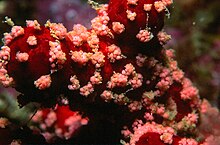Alcyonium acaule
| Alcyonium acaule | |
|---|---|

| |
| Scientific classification | |
| Kingdom: | |
| Phylum: | |
| Class: | |
| Subclass: | |
| Order: | |
| Family: | |
| Genus: | |
| Species: | A. acaule
|
| Binomial name | |
| Alcyonium acaule Marion, 1878[1]
| |
Alcyonium acaule or Mediterranean sea-finger is a species of soft coral in the Alcyoniidae family. It is found at moderate depths on shaded rocks in the Mediterranean Sea and adjoining parts of the Atlantic Ocean.
Description
Mediterranean sea-finger is a colonial coral forming clumps of yellow, pink, brown-red to brown orange fleshy masses of finger-like lobes. The colony can reach an height of 20 cm maximum.[2] The body's surface is entirely covered by whitish polyps from the foot to the top of the lobes. As for all the soft coral, it uses its hydrostatic skeleton capacity to maintain and manage its body posture.
Distribution and habitat
This species is endemic to the Mediterranean Sea however its area of distribution overflows slightly and extends along the Portuguese and Spanish Atlantic coasts. It is usually found between 12 and 135 m deep.[3] Alcyonium acaule is a sciaphilous animal that likes to avoid places exposed to unfiltered light and prefers shaded places such as overhangs or caves.
Ecology
In the Mediterranean Sea, Alcyonium acaule frequently forms dense agglomerations, often in association with the yellow cluster anemone (Parazoanthus axinellae). Other organisms in these biodiverse habitats include suspension feeders such as sponges, cnidarians, bryozoans and tunicates, and the rock is encrusted with coralline algae. There is space competition among these organisms and during a two-year research study, a number of small colonies of Alcyonium acaule disappeared, and very little growth of colonies occurred. Many colonies showed less feeding activity during the summer, with up to ninety percent becoming dormant.[4]
References
- ^ van Ofwegen, Leen (2015). "Alcyonium acaule Marion, 1878". WoRMS. World Register of Marine Species. Retrieved 2015-08-15.
- ^ http://doris.ffessm.fr/fiche2.asp?fiche_numero=91
- ^ Steven Weinberg, Découvrir la Méditerranée, Nathan nature, 2007, 352 p. (ISBN 9782092781128)
- ^ Joaquim Garrabou (1999). "Life-history traits of Alcyonium acaule and Parazoanthus axinellae (Cnidaria, Anthozoa), with emphasis on growth". Marine Ecology Progress Series. doi:10.3354/meps178193.
